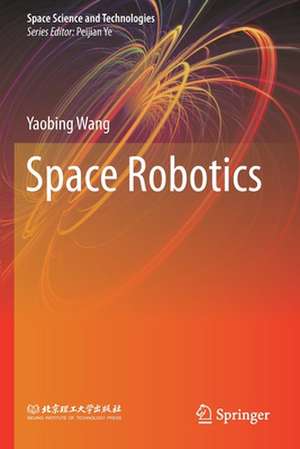Space Robotics: Space Science and Technologies
Autor Yaobing Wangen Limba Engleză Paperback – 12 sep 2021
This book provides readers with basic concepts and design theories for space robots and presents essential methodologies for implementing space robot engineering by introducing several concrete projects as illustrative examples. Readers will gain a comprehensive understanding of professional theories in the field of space robots, and will find an initial introduction to the engineering processes involved in developing space robots.
Rapid advances in technologies such as the Internet of Things, Cloud Computing, and Artificial Intelligence have also produced profound changes in space robots. With the continuous expansion of human exploration of the universe, it is imperative for space robots to be capable of sharing knowledge, working collaboratively, and becoming more and more intelligent so as to optimize the utilization of space resources. For on-orbit robots that perform service tasks such as spacecraft assembly and maintenance, as well as explorationrobots that carry out research tasks on planetary surfaces, the rational integration into a network system can greatly improve their capabilities in connection with executing outer space tasks, such as information gathering and utilization, independent decision-making and planning, risk avoidance, and reliability, while also significantly reducing resource consumption for the system as a whole.
| Toate formatele și edițiile | Preț | Express |
|---|---|---|
| Paperback (1) | 1111.97 lei 6-8 săpt. | |
| Springer Nature Singapore – 12 sep 2021 | 1111.97 lei 6-8 săpt. | |
| Hardback (1) | 1118.13 lei 6-8 săpt. | |
| Springer Nature Singapore – 11 sep 2020 | 1118.13 lei 6-8 săpt. |
Preț: 1111.97 lei
Preț vechi: 1356.06 lei
-18% Nou
Puncte Express: 1668
Preț estimativ în valută:
212.80€ • 221.35$ • 175.68£
212.80€ • 221.35$ • 175.68£
Carte tipărită la comandă
Livrare economică 14-28 aprilie
Preluare comenzi: 021 569.72.76
Specificații
ISBN-13: 9789811549045
ISBN-10: 9811549044
Ilustrații: XVII, 363 p. 173 illus., 15 illus. in color.
Dimensiuni: 155 x 235 mm
Greutate: 0.54 kg
Ediția:1st ed. 2021
Editura: Springer Nature Singapore
Colecția Springer
Seria Space Science and Technologies
Locul publicării:Singapore, Singapore
ISBN-10: 9811549044
Ilustrații: XVII, 363 p. 173 illus., 15 illus. in color.
Dimensiuni: 155 x 235 mm
Greutate: 0.54 kg
Ediția:1st ed. 2021
Editura: Springer Nature Singapore
Colecția Springer
Seria Space Science and Technologies
Locul publicării:Singapore, Singapore
Cuprins
Introduction.- Kinematics and Dynamics of Space Robots.- Motion Planning of Space Robot.- Motion Control of Space Robots.- Force Control of Space Robot.- Space Robot System.- Space Robot Mechanical System.- Space Robot Control System.- Space Robot Perception System.- Space Robot Teleoperation System.- Space Robot System Verification.- Design Example of Large Space Manipulator.- Design Example of Planetary Exploration Mobile Robot.- Design Example of Planetary Surface Sampling Manipulator.- Current State of Space Robots.- Future Prospects of Space Robots.
Notă biografică
Yaobing Wang,Ph.D.,research professor of Beijing Institute of Spacecraft System Engineering, director of Beijing Key Laboratory of Intelligent Space Robotic Systems Technology and Applications. His research interests focus on space robotics and spacecraft structure and mechanisms.
Textul de pe ultima copertă
This book provides readers with basic concepts and design theories for space robots and presents essential methodologies for implementing space robot engineering by introducing several concrete projects as illustrative examples. Readers will gain a comprehensive understanding of professional theories in the field of space robots, and will find an initial introduction to the engineering processes involved in developing space robots.
Rapid advances in technologies such as the Internet of Things, Cloud Computing, and Artificial Intelligence have also produced profound changes in space robots. With the continuous expansion of human exploration of the universe, it is imperative for space robots to be capable of sharing knowledge, working collaboratively, and becoming more and more intelligent so as to optimize the utilization of space resources. For on-orbit robots that perform service tasks such as spacecraft assembly and maintenance, as well as explorationrobots that carry out research tasks on planetary surfaces, the rational integration into a network system can greatly improve their capabilities in connection with executing outer space tasks, such as information gathering and utilization, independent decision-making and planning, risk avoidance, and reliability, while also significantly reducing resource consumption for the system as a whole.
Caracteristici
Provides detailed concepts and design theories for space robots Presents essential methodologies for developing space robots based on the first-hand experience of frontline engineers and technicians Discusses several illustrative engineering projects on space robot development, making it a valuable guide for researchers and engineers, both theoretically and practically










